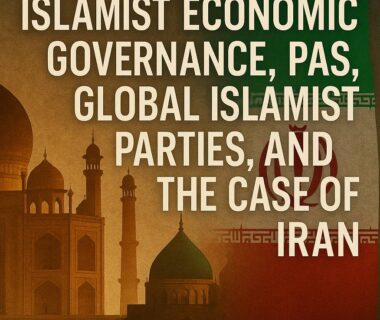Hello and welcome back, sepupus! (Psst! Join our Telegram group!)
Politics is not conventionally considered a part of Economics, but in reality, the subjects are deeply intertwined; Economics is the art of allocating resources to best meet the unlimited wants of humans in the best possible ways, while politics in many ways decides what every society and economy deems best.
The relationship goes a little further than that, but the first ‘economists’ like Adam Smith, Ricardo, JS Mill, and Karl Marx were political economists – they wrote not only about how resources are allocated in society, but also institutions, laws, class relations, governance, and moral philosophy.
These aren’t topics I’ve written about just yet, but they are things I will touch on a little later.
Meanwhile, today, we will be talking about Islamist economic governance, focusing on PAS and later Iran. Exciting topic – normally, this would be a premium resource given the amount of research that has gone into it, but in this instance, your access will be free although you will have to register in order to read this piece in full.
Why?
Well, because today, I saw a strange recommendation from former Minister in the Prime Minister’s Department for Legal Affairs and Judicial Reform, Zaid Ibrahim.
This was what I first saw when MalaysiaKini reported the matter.

I could not believe what he had said, and there was a part of me that just immediately had something almost akin to an allergic reaction. Iran? Like, in the middle of a war and being threatened by Donald Trump Iran?
Before long, I had started writing, and the result is what you see today – Which begins by understanding what Zaid actually said.
Here is what Zaid said:
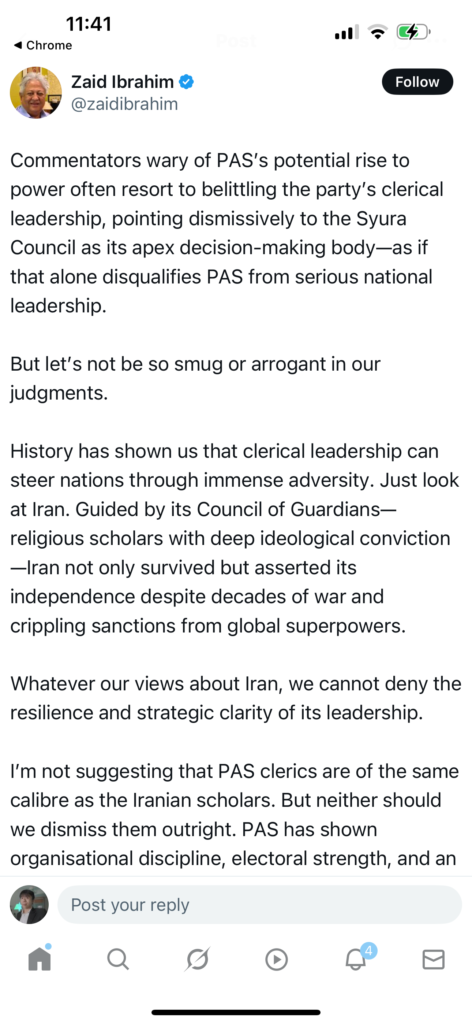
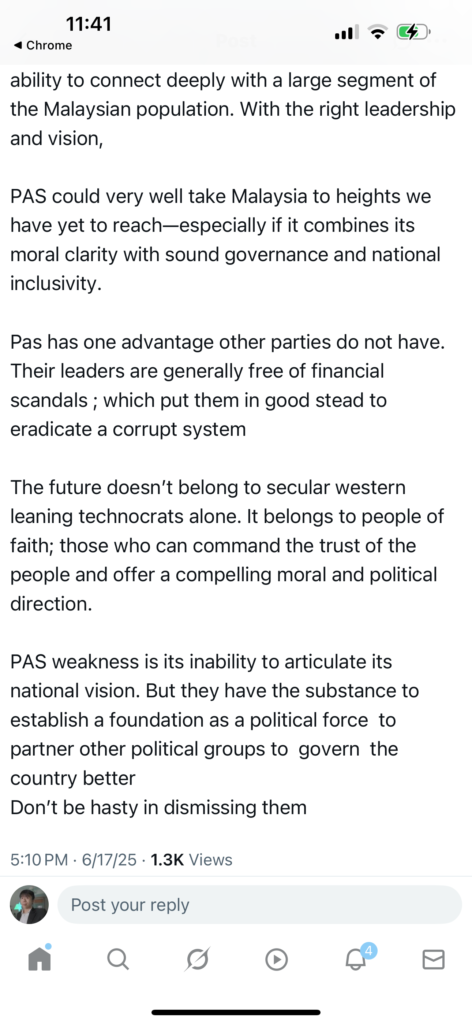
I find Zaid’s opinion interesting. I respect Zaid’s right to his opinion, but I do not share it for various reasons, including the fact that an ulama council would not be elected and would not be subject to democracy – not that PAS really respects democracy beyond a means to an end to confront the fact that their end goal is impossible under the conditions of the nation state, but certainly, we can see that they try.
In the very first place, it is unclear that PAS respects the constitution of Malaysia or our monarchy (Feat. A discussion between me and Dr. Azmil Tayeb), and it has been rebuked by the royals for that specific reason, preaching respect for royalty only when it is convenient for them.
I would also observe that PAS may have tried to offer a moral and political direction, but it appears that what we have is repeated instances of lawsuits because of slander, shaky assertions from leaders such as Siti Mastura and Razman Zakaria, what seems to be a culture of facilitating that slander and hate speech on the part of its leaders, heady declarations against non-Muslims asserting that they cannot and should not have political power and that no matter what, Malay Muslims must rule and other races are safe only IF that is the case, failure to address drug addiction, maintain water infrastructure, and so on and so forth while they maintain moral and religious policing while peddling hatred with no clear or apparent benefit, and preach morality while failing to maintain moral standards amongst the populace while insisting that it is only with their governance that they can ensure a moral population despite minimal evidence that they have succeeded in any meaningful way on that front unless morality is racial saber rattling, pretending to ‘protect’ people while trying to co-opt racial causes built on scaring their own race, including people who visited Christmas celebrations by choice, supporting individuals punished for the charge of slandering people and thereby jeopardising their right to religious freedom (See: Becoming Hannah), while pretending they are the representatives of the Malays, repeatedly lying about their political opponents, imagining that disasters involving foreign nationals are a ‘punishment from God’ with half-baked logic, and then reaping the rewards of their logic by praying for concerts to be canceled by rain only to receive floods in their states. This they do while stifling critical thinking across almost every dimension while preaching a constant narrative about their being oppressed or colonized in every way, while casually trying to establish dominance, betraying their political partners…
Oh, how about the part where they even tried to conduct foreign interference into Singapore, peddling influence of a flavor that Ahmad Mattar from the PAP alleged was one of the PAP’s deep concerns (Page 254 – 255, The Singapore Dilemma by Lily Zubaidah Rahim – now selling for the pretty price of RM1179.20 on Shopee, and SGD81 on Kinokuniya Singapore – or it would be if it weren’t out of stock) and gaslighting Singaporean Malays, as part of tag teams with individuals of questionable repute such as Noor Deros?


Need I say more?
Let’s also observe that netizens too do not share his opinion, although note that this is merely one part of the echo chamber, and there are more echo chambers out there – do read widely to avoid that, and don’t take what I say as the truth without evaluation.
Also, opinions are not evidence or truth – but they do say something. Consider some of the truth conveyed by the comments below.
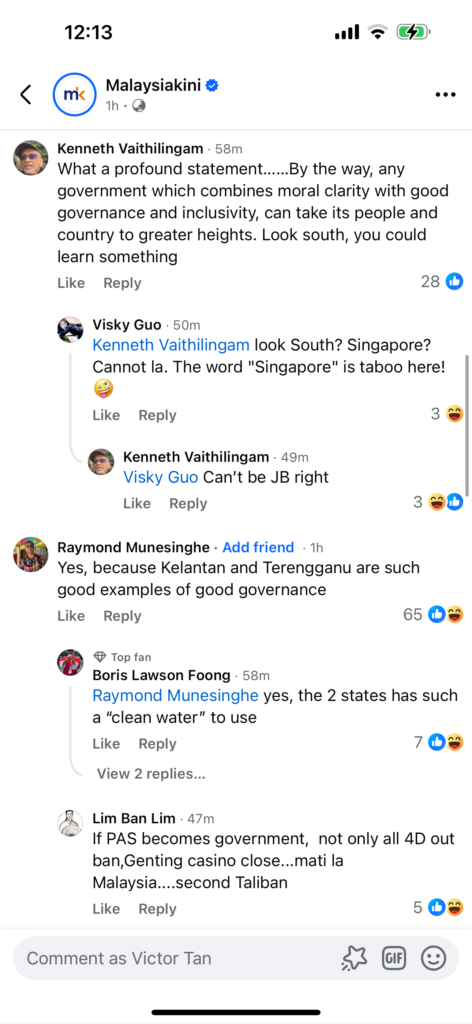
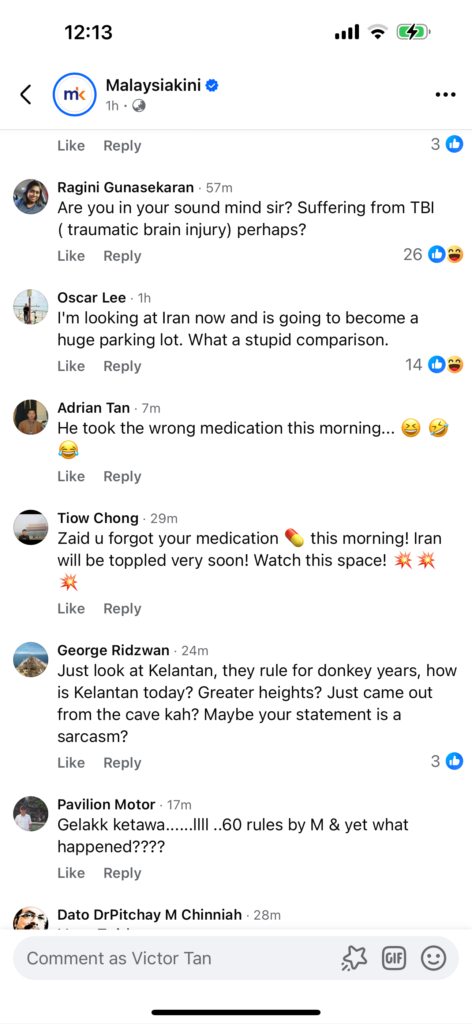
As for no financial scandals?
Maybe.
But then Clare Rewcastle-Brown might disagree on that point.

Well, Zaid is entitled to his opinion – but if you were to ask me?
It is my opinion that constitutionally, ethically, educationally, developmentally, institutionally, environmentally, socially, and culturally, PAS has failed.

In other words?
Well, Zaid said that PAS can “take Malaysia to heights we have yet to reach”.
That’s interesting.
Do we have proof that they have done so that somehow we have a confidence that they have the ability to govern the present as a rational basis for the future?
Do we have any proof that they can do that beyond their feeble statements in parliament, and their whataboutism involving DAP?
What’s the verdict?
It is not encouraging.
If it is true as Zaid says that PAS can “take Malaysia to heights we have yet to reach”, that does not really seem to be related to its religious agenda, and it would appear that it has to be tied directly to what is common to all of us after you cut away everything else.
This brings us now to our main topic.
That’s right, sepupus.
This is Sepupunomics, and it logically follows that we must talk about the economy.
PAS and the Economy
We discussed the numerous failures of PAS on multiple fronts earlier, all of which relate in nuanced ways to methods of capturing standards of living that stand beyond the usage of gross domestic product per capita – to demonstrate that PAS has failed on all of those fronts.
If PAS administration is good administration, then that logically must mean that it is able to push Malaysia forward to achieve goals such as standards of living improvements – Rather than just religious sabre-rattling and moral policing while hoping for sedekah or rezeki or for parties like DAP to do research through their think tanks on matters like the hydrogen transition, National Energy Transition Roadmap, National Semiconductor Strategy, or the New Industrial Master Plan 2030.
What do we mean?
If we are to say that PAS can in fact rule Malaysia, then they must be able to deal with the Malaysian economy and show proof that they can deal with the Malaysian economy.
Otherwise, it is meaningless to talk about the concept of ‘advancement’ in the first place.
Let’s understand what PAS is doing with what it has at the moment to try to understand whether it has what it takes to deal with the rest of the country and in turn deal with the rest of the world.
PAS‐Ruled States in Context
It would not be fair to declare that the present state of PAS-run states is purely the result of PAS administration, and we have to look at what all these governments were dealing with beforehand – a very important part of economic logic.
In economic terms, what happened on the margin?
In other words, what happened as a result of PAS administration that would not have as a result of PAS administration, to the extent that we know it?
In the best case scenario, we would be able to split up reality into two dimensions, and have PAS rule one set of states and another dimension where PAS did not rule those states, and then compare the economic differences.
Unfortunately, we only have one reality to look at, and we cannot completely know what an alternate history would look like where PAS ruled states were not ruled by PAS.
However, we can make comparisons across states in order to get ourselves an idea.
With that in mind, let’s first have a look at what PAS is dealing with and its timeline of control to understand what they have done with the economies of the states they have ruled.
Timeline of PAS Control
| State | PAS First Took Office | Periods of Rule | Quick Context at Handover |
|---|---|---|---|
| Kelantan | Oct 1990 | Continuous since 1990 | Already Malaysia’s poorest; GDP pc ≈ RM3–4 k in 1990 (≈15 % of national). Rural, rubber-rice economy and ageing infrastructure. |
| Terengganu | Nov 1999 | 1999-2004, then again since May 2018 | Inherited an oil-rich state (royalty > RM1 bn/yr) but BN had financed many prestige projects; PAS immediately lost royalty as Putrajaya converted it to wang ehsan cash grants (thenutgraph.com). |
| Kedah | Mar 2008 | 2008-2013 (Pakatan-PAS), lost, then since May 2020 | Took over a state with Kulim High-Tech Park (1990s BN legacy) and large paddy sector; manufacturing cluster linked to Penang supply chains. |
| Perlis | Nov 2022 | Since 2022 | Tiny, agrarian economy; PAS administration too recent for trend analysis. |
1 What Has Happened to the Numbers under PAS?
Let’s compare the growth rates of PAS economies as compared to Malaysia as a whole as a baseline to understand what we are working with.
Key idea: Instead of looking only at today’s ringgit values, compare how fast each state’s GDP per capita (current prices) has grown since 2015 ― the first year with a consistent DOSM time-series. Eight years is long enough to see whether PAS administrations are closing the gap with the rest of Malaysia.
| State | PAS in power* | GDP pc 2015 (RM) | GDP pc 2023 (RM) | Nominal compound growth 2015-23 | 2023 level vs. national avg. (RM 54 612) |
|---|---|---|---|---|---|
| Kelantan | since 1990 | 12 075 | 16 836 | +4.2 % a year | 31 % of national (en.wikipedia.org) |
| Terengganu | 1999-2004, 2018-now | 26 529 | 31 111 | +2.0 % a year | 57 % of national (en.wikipedia.org) |
| Kedah | 2008-13, 2020-now | 18 249 | 26 353 | +4.7 % a year | 48 % of national (en.wikipedia.org) |
| Perlis | since 2022 | 20 196 | 24 004 | +2.2 % a year | 44 % of national (en.wikipedia.org) |
| Malaysia (average) | — | 37 104 | 54 612 | +5.0 % a year | 100 % (en.wikipedia.org) |
| Penang (for contrast) | non-PAS | 44 847 | 72 586 | +6.2 % a year | 133 % (en.wikipedia.org) |
| Selangor (largest economy) | non-PAS | 42 611 | 62 492 | +4.9 % a year | 114 % (en.wikipedia.org) |
* PAS first entered Kedah in 2008, lost in 2013, and returned in 2020. Terengganu had a BN interlude 2004-18.
What the numbers mean – in plain language
- Kelantan: grew by about 4 % a year, but Malaysia as a whole grew faster (5 %). That means Kelantan has slid from 32 % of the national average in 2015 to 31 % today. Put simply: it’s still the poorest state and is not catching up despite three decades of uninterrupted PAS rule.
- Terengganu: even with billion-ringgit oil royalties, its income per person rose just 2 % a year – the slowest of any PAS state and far below the national pace. In 2015 an average Terengganu resident earned 71 % of the national mean; by 2023 that share is 57 %. The gap widened.
- Kedah: the bright spot among PAS states. Thanks largely to the pre-existing Kulim High-Tech Park and Penang spill-overs, Kedah grew almost as fast as Malaysia. Yet its citizens still earn less than half the national average, so the distance hasn’t really narrowed.
- Perlis: PAS only took office at end-2022, so its below-average trend (2 % growth) mostly reflects long-standing structural limits of a small, rural economy.
- Penang & Selangor (benchmarks): These non-PAS states show what higher growth (5–6 % a year) looks like. Both started ahead and pulled further away – which is NOT what we would expect.
How about Poverty?
2022 Absolute-Poverty Rates by State
(Department of Statistics Malaysia – Household Income Survey)
| State | 2022 poverty rate (% of households)* | Notes |
|---|---|---|
| Sabah | 19.5 % | Highest in the country (sdg-for-malaysian-states-sdsn.hub.arcgis.com) |
| Kelantan ★ | 12.4 % | Second-highest; long-run PAS administration (sdg-for-malaysian-states-sdsn.hub.arcgis.com) |
| Terengganu ★ | 12.0 % | Heavily oil-royalty dependent; PAS since 2018 (sesricdiag.blob.core.windows.net) |
| Sarawak | 9.0 % | Large rural interior (sdg-for-malaysian-states-sdsn.hub.arcgis.com) |
| Kedah ★ | 9.0 % | PAS-led since 2020; figure crept up from 8.8 % (2019) (en.wikipedia.org) |
| Perlis ★ | 8.9 % | PAS only from late 2022; tiny agrarian state (DOSM dashboard) (sesricdiag.blob.core.windows.net) |
| Perak | 7–8 % | Mixed agriculture/industrial belt (DOSM dashboard) |
| Pahang | ~7 % | Large rural east-coast interior (DOSM dashboard) |
| Johor | 3.9 % | Diversified, manufacturing & services hub (sesricdiag.blob.core.windows.net) |
| Melaka | 3.9 % | Tourism–manufacturing mix (sesricdiag.blob.core.windows.net) |
| Pulau Pinang | 3.9 % | Electronics cluster, high urbanisation sesricdiag.blob.core.windows.net |
| Negeri Sembilan | 4.3 % | Commuter belt to Klang Valley (sesricdiag.blob.core.windows.net) |
| Selangor | 1.5 % | Malaysia’s richest state (aei.um.edu.my) |
| W.P. Kuala Lumpur | 1.4 % | High-income, service economy (aei.um.edu.my) |
| W.P. Labuan | 0.4 % | Offshore finance hub (aei.um.edu.my) |
| W.P. Putrajaya | 0.2 % | Civil-service enclave, small population (aei.um.edu.my) |
Plain-English take-aways
- Poverty is clearly higher in PAS-governed states.
- Kelantan and Terengganu are the only states on Peninsular Malaysia with double-digit poverty rates.
- Kedah and Perlis also sit well above the national average despite far smaller populations.
- Royalty money isn’t a silver bullet.
- Terengganu receives > RM1 billion in oil royalties most years, yet its poverty rate (12 %) is only slightly better than Kelantan’s (no royalties).
- The quality of spending and economic diversification are stronger predictors of outcomes than the size of fiscal transfers.
- Urban, diversified states do best.
- Selangor and Kuala Lumpur post poverty rates near 1 % thanks to broad-based job creation in manufacturing and services.
- Penang, with an electronics export hub, keeps poverty under 4 % despite limited natural resources.
- East-Malaysia outlier.
- Sabah’s 19.5 % underscores that geography and late infrastructure catch-up still matter; it is not a PAS state, showing that party control is only one factor.
- Trend since 2019:
- Poverty nationwide rose sharply during COVID-19 (8.4 % in 2020) and eased to 6.2 % in 2022, but PAS states have been slower to recover, partly due to weaker tourism and outward migration of workers.
In short, PAS-run states consistently occupy the higher-poverty end of Malaysia’s spectrum, and while limited royalties (Kelantan) or boom-bust royalties (Terengganu) contribute, the persistent gap points to deeper issues of investment climate, industrial mix, and human-capital retention rather than fiscal transfers alone.
2 What PAS Inherited vs. What Changed
Kelantan
- Starting point (1990): Poorest state, weak industrial base, poor road/water networks, but strong overseas remittances from migrant Kelantanese.
- PAS record:
- Limited capital spending—average development allocation < RM700 m/year vs > RM2 bn in most states.
- Tight syariah-first bylaws (gender-segregated cinemas, alcohol curbs) seen by investors as red-tape; ISEAS notes “low private-sector dynamism” and out-migration of talent(iseas.edu.sg).
- Oil royalty dispute: offshore deposits are beyond 3 n mi; Kelantan receives token goodwill money only (RM 58 m April 2025)(theedgemalaysia.com).
- Outcome: GDP pc climbed, but only from 15 % to 31 % of national level; poverty remains > 20 %. Water losses (non-revenue water > 50 %) and roads top public-complaint list(theedgemalaysia.com).
Terengganu
- Starting point (1999): An oil province with royalties > RM1 bn/yr; BN trophy projects (Crystal Mosque, Monsoon Cup) but limited diversification.
- First PAS term (1999-2004): Federal government withheld royalties; growth stalled; PAS lost 2004.
- Second PAS term (2018-present): Royalties restored—RM 1.05 bn in 2018, ~RM 1.27 bn in 2019(malaymail.com)(malaymail.com)
- Structural flaw: 70 % of revenue from royalties; MARC Ratings flags “crowding-out” of tax effort and boom-bust budgets(marc.com.my). Non-oil GDP share stagnant.
Kedah
- Starting point (2008): Paddy belt+Kulim High-Tech Park (Intel, OSRAM); poverty falling.
- PAS 1st era (2008-2013): Focus on smallholder schemes & religious schools; disputes with Penang over water pricing dampened interstate cooperation; electronics cluster continued under MNCs.
- PAS return (2020-): New agenda on rare-earth mining, solar parks; water dispute persists; SG4 bloc created with Dr Mahathir as adviser to lure FDI(straitstimes.com).
- Scorecard: GDP pc rose but to only 57 % of national; poverty at 9 % (higher than 2009’s 5–6 %).
Perlis
- PAS/PN only since 2022; too early for data shifts. Baseline: small agriculture, border trade with Thailand.
3 Systemic Differences in PAS Governance
| Feature | How PAS States Differ | Economic Consequence |
|---|---|---|
| Fiscal Model | Heavy reliance on federal transfers (Kelantan) or oil royalties (Terengganu); low own-source taxes. | Volatile budgets, under-investment in infrastructure during downturns. |
| Regulatory Climate | Moral bylaws (liquor, entertainment segregation) stricter; local councils dominated by party cadres (iseas.edu.sg). | Adds compliance costs; tourism & service SMEs complain of red-tape, deterring diversification. |
| Development Priorities | Higher share of spending on religious schools, welfare stipends; lower on industrial parks, R&D. | Slower tech & manufacturing catch-up vs. neighbour Penang; brain-drain of graduates. |
| Oil Windfalls | Terengganu spends >60 % of royalty on operating outlays rather than long-term funds; Kelantan lacks such windfall but similar outcome. | Classic “resource curse”: consumption today, limited savings for tomorrow. |
| Inter-governmental Relations | Periodic royalty and grant disputes with federal govt. | project delays (water, highways), investor uncertainty. |
4 Did Anything Improve under PAS?
- Human development: Literacy rates and basic amenities (electricity, piped water) improved nationwide, including PAS states. DOSM shows Kelantan’s rural electrification > 98 % by 2022 (from < 60 % in 1990).
- Industrial enclaves: Terengganu’s downstream oil & gas cluster (Kertih) kept expanding; Kedah’s Kulim Park attracted higher-end chip back-end plants—both projects originated pre-PAS but were not derailed.
- SG4 experiment (2024-): First proactive effort by PAS administrations to pool resources and seek FDI collectively; still untested but signals a shift from grievance politics to deal-making.
Is “Lack of Oil Royalties” the Whole Story?
No. Kelantan’s chronic poverty correlates with zero or low royalties, yet Terengganu shows that having > RM1 bn/year royalties doesn’t ensure prosperity; governance quality and diversification matter.
Oil cash is neither a silver bullet nor the root of all woes; it magnifies whatever institutional strengths or weaknesses already exist.
5 Bottom Line
- PAS took over already-lagging states, but the gap with the national average has not closed; in relative terms Kelantan and Kedah remain stuck, Terengganu slid somewhat, and Perlis is unchanged.
- Structural choices—fiscal dependence, moral-regulatory conservatism, modest investment in growth sectors—explain more of the under-performance than royalties alone.
- The new SG4 bloc may indicate learning—but until PAS states address core issues (talent outflow, business climate, revenue diversity), oil checks or federal grants will continue to fund subsistence, not transformation.
Key Sources: DOSM state GDP & poverty datasets(en.wikipedia.org)(dosm.gov.my)(open.dosm.gov.my); CEIC state GDP series(ceicdata.com); oil-royalty payments reports(theedgemalaysia.com)(malaymail.com); ISEAS studies on PAS governance(iseas.edu.sg)(bookshop.iseas.edu.sg); Straits Times on SG4 formation(straitstimes.com); MARC Rating on Terengganu dependency(marc.com.my).
The Oil Royalty Question
Now perhaps Zaid or PAS politicians would like to talk about how in fact they have been deprived of royalties and don’t have the money and cannot develop.
Let’s now consider that aspect of the argument. In relation to what we can see from the moral policing that is characteristic of PAS states.
Why growth lags despite (or regardless of) oil money
- Oil royalties aren’t everything
- Terengganu proves that having RM 1 billion-plus a year is no guarantee of faster growth; poor diversification and stop-go spending blunt the benefit.
- Investment climate matters
- Kelantan’s restrictive by-laws (gender-segregated entertainment, liquor curbs) and limited infrastructure make investors choose Penang or Selangor instead.
- Fiscal model
- Kelantan relies on federal grants; Terengganu on royalties. Both spend heavily on salaries and welfare, leaving less for productive capital projects that raise long-run incomes.
- Human-capital leakage
- Young professionals from PAS states migrate to Klang Valley or Penang for better jobs, so local productivity growth stays low.
Take-away in one sentence
Over 2015-23 all PAS-run states grew in absolute terms, but—except for Kedah—they grew slower than Malaysia as a whole, so their people are not catching up in relative prosperity.
That shortfall stems more from policy and governance choices than from the presence or absence of oil royalties alone.
Wow, that was a long discussion. Give yourself a round of applause and sip some tea.
What can we see here?
We can see that even though PAS took over from other parties that were already lagging, they did not raise their states to new heights.
They are not doing so, there is no evidence that they are able to do so, and any potential indication that they will raise Malaysia to greater heights is wishful thinking and is likely ideological rather than on the basis of the existing data about PAS governance.
But wait, Mr. Zaid might say, “Past (PAS?) results do not guarantee the future!”
How wonderful. Therefore, we should not support your favourite party.
Maybe he will say:”Well, the statistics show that the Malay support PAS!”
How wonderful. Therefore, it is desirable for non-Malays to migrate unless there is deep evidence indicating that there will be a tectonic shift. That evidence is not present in your states and is at best based on a vain promise that is not supported by any earthly thing. We do not believe in your spiritual things, and based on your actions as identified above, it seems reasonable to conclude that many of you do not either.
Oh, but then…”You haven’t looked at what the people in Iran are doing! Clearly, they are deeply more capable!”
I’m glad that you asked!
Because this analysis includes also what our friends in Iran and in fact all Islamist parties around the world are doing.
With that in mind, here is a full-scale analysis of Iran which Mr Zaid seems to love so much, to establish a comparison between PAS and its existing failures that in turn do not tell a touching or inspiring tale about the economic future of this country if that governance were extended to the rest of Malaysia.
Introduction
Islamist political parties – those seeking to govern by Islamic principles – have had varied success in managing economic affairs. This report examines their economic governance across several countries (including Malaysia’s PAS) and then focuses on Iran.
We compare Iran’s economic progress before and after the 1979 Islamic Revolution, in percentage growth terms, against world averages. We also consider the role of oil, private enterprise, and other factors in Iran’s economic trajectory. Finally, we analyze common trends in how Islamist-led regimes affect economic growth.
I’d like to briefly interrupt this discussion to let you know that the next section will be a membership required section.
In normal premium resources like this one, you will have to sign up for a membership to access the content. However, in this case, you can just sign up for a free membership by signing up at the link below. By signing up for a membership, you affirm your consent to receive communications from sepupunomics.com.
If you haven’t signed up yet, make sure to Join Now!
